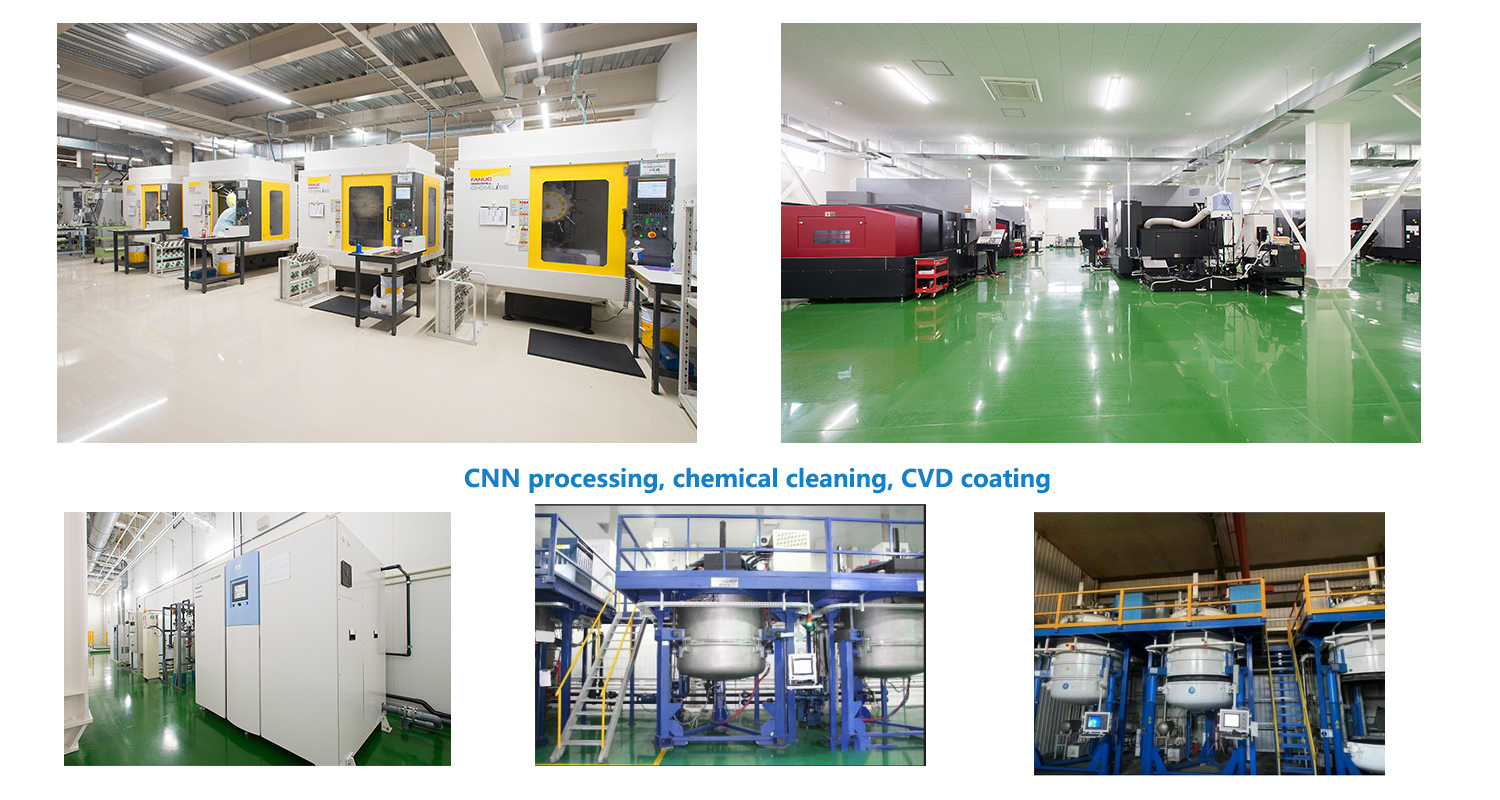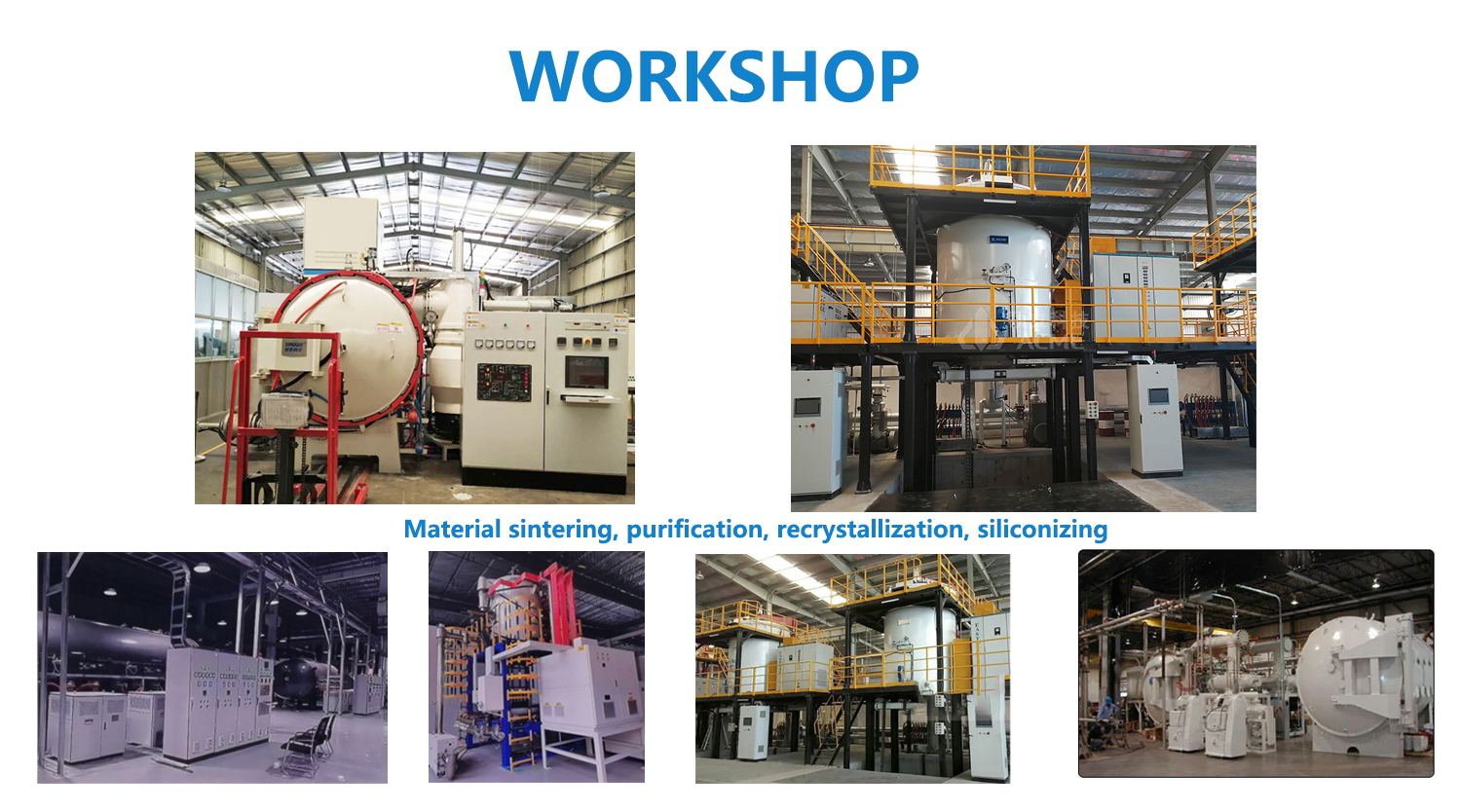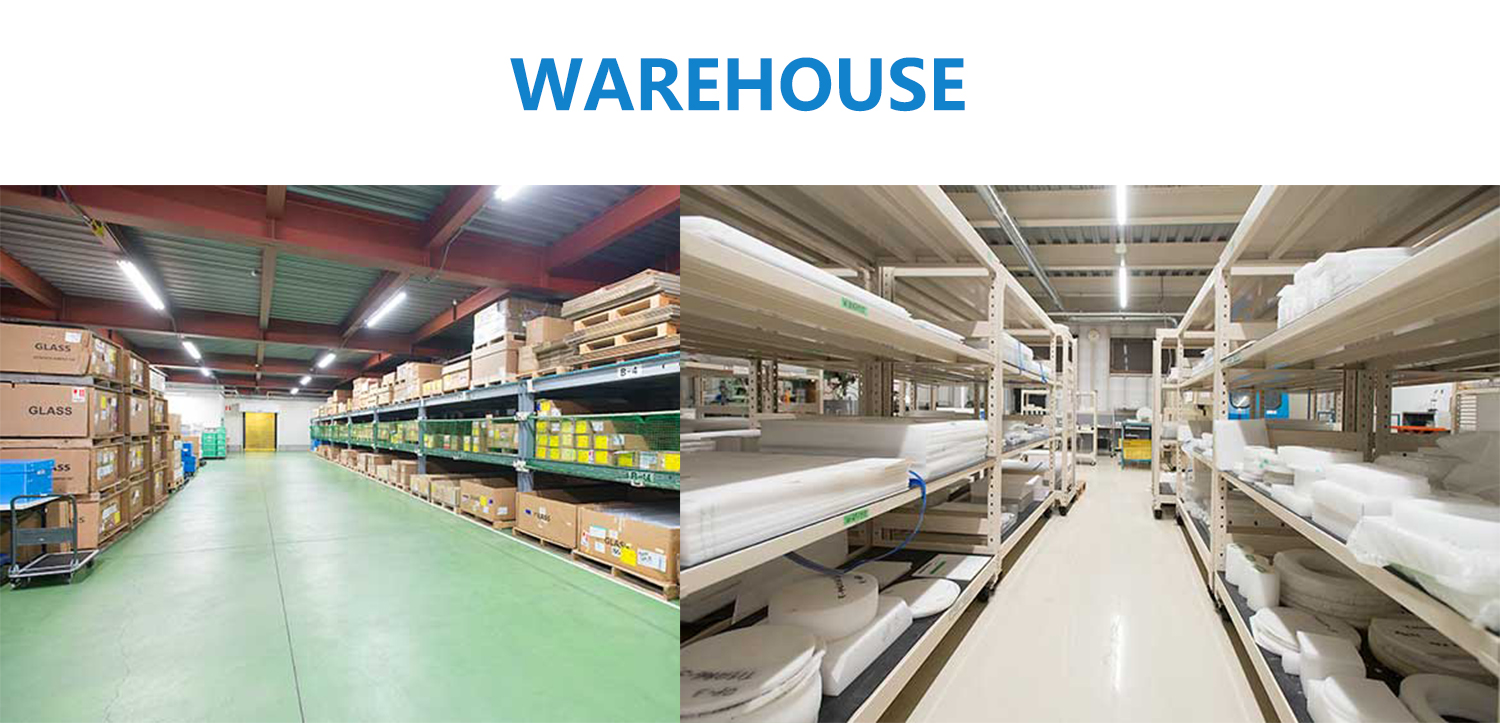
焼結炭化ケイ素のウエファー ボートはハイテクな企業で必須の部品で、比類のない性能および信頼性を提供します。 ザ・オブ・ザ・ 反応焼結炭化ケイ素ウェハーボート、高度と造られる SiCコーティング、優秀な強さおよび耐久性のために祝われる材料炭化ケイ素の優秀な質を、実行して下さい。 これらのウェーハボートは、半導体製造に欠かせない極端な条件に耐えるように設計されています。 コーナーストーンとして 半導体セラミックス, 反応 焼結炭化ケイ素のウエファー ボート 要求の厳しいプロセスでも精度と効率を保証します。 この革新的な技術は、現代の産業用途における炭化ケイ素の重要な役割を果たしています.
要点
- 焼結炭化ケイ素のボート 熱および化学薬品を非常によく抵抗して下さい.
- 1000°C以上で頑丈な作業で安心.
- 強度と硬さは、重い使用下で耐久性を発揮します.
- これらのボートは錆に抵抗し、摩耗します、粗い環境のために完成します.
- それらは合うためにカスタマイズすることができます 異なった産業必要性 簡単に.
- メンテナンス不要で、時間をかけて節約できます.
- 廃棄物を削減し、エネルギーを節約することにより、環境を支援します.
- ハイテク産業は、その強力な性能のために、これらのボートを必要としています.
焼結炭化ケイ素のウエファーのボートの独特な特性
High Thermal and Chemical Resistance
焼結炭化ケイ素のウエファー ボート 耐熱性・耐薬品性に優れた環境に優れています。 これらのボートは驚くべきことを示しています 熱伝導性、126 W/m・Kで測定される高温プロセスの間に有効な熱伝達を保障する、。 450°の熱衝撃抵抗 Cは、割れや変形せずに迅速な温度変化に耐えることができます。 精密・安定性が重要である半導体製造に最適です.
素材の熱安定性は、別のスタンドアウト機能です。 それはできます 1000°Cを超える極端な温度に耐える 、長期信頼性を保障しない歪むこと。 さらに、焼結炭化ケイ素は熱ホットスポットの形成を防ぐ、優れた熱放散を提供します。 このプロパティは、繊細な半導体コンポーネントの完全性を維持するために不可欠である温度分布さえ保証します。 さらに、化学腐食に対する高い抵抗により、反応性ドパントガスなどの積極的な化学環境で確実に実行できます.
優れた機械的強度と硬度
焼結炭化ケイ素のウエファー ボートは優秀な機械強さおよび硬度のために有名です。 これらの特性はそれらを非常に耐久および産業適用の機械圧力を理解することが可能にします。 材料の 2550~2800Knoopの硬度範囲、利用できる最も堅い陶磁器の間でそれを置く。 重負荷下でも摩耗や変形に抵抗を発揮します.
焼結炭化ケイ素の強さは59から108のkpsiに及んでいます、圧縮強さは印象的な550のkpsiに達します。 これらの値は、曲げと圧縮力の両方を失敗することなく耐える能力を強調します。 反応結合された炭化ケイ素と比較されて、焼結させた変形は次テーブルで示すようにかなりより高い圧縮強さおよび硬度を提供します:
| プロパティ | 焼結炭化ケイ素 | 反応結合された炭化ケイ素 |
|---|---|---|
| 圧縮強度 | 3680 MPa | 焼結した変形よりも低い |
| ノップ硬度 | 2810 | 焼結した変形よりも低い |
これらの機械的特性は焼結させた炭化ケイ素のウエファー ボートを半導体および宇宙空間の企業のそれらを含むデマンドが高い適用のための信頼できる選択にします.
優秀な腐食および摩耗の抵抗
焼結炭化ケイ素のウエファー ボートはまた腐食および摩耗への例外的な抵抗のために際立っています。 このプロパティは、これらの関与する酸や研磨材などの過酷な環境での耐久性を保証します。 材料の耐食性はそれに積極的な物質への露出が共通である化学処理および精製の塗布のために特に適します.
その耐摩耗性は均等に印象的であり、摩擦や研磨粒子の高い環境で確実に実行することができます。 これにより、ブッシュ、プレート、サンドブラストノズルなどのコンポーネントに最適です。 以下の表は、これらの機能を要約します
| Feature | 説明 |
|---|---|
| 耐食性 | 、特に酸、弁の塗布のための理想の顕著な抵抗. |
| 耐摩耗性 | 要求する環境のために適した優秀な耐久性. |
| Application | 化学処理、精製、採掘、パルプおよびペーパー処理の実績. |
これらの特性は焼結させた炭化ケイ素のウエファー ボートが最も挑戦的な条件でさえ延長期間上の性能そして完全性を維持することを保障します.
顕著な熱伝導性および酸化抵抗
焼結炭化ケイ素のウエファー ボートは例外的な熱伝導性および酸化の抵抗を表わします。 これらの特性は、極端な条件下で高い性能を要求する業界で不可欠です。 材料の熱伝導性は、126 W/m・Kで測定され、有効な熱伝達を保障します。 半導体製造において重要な高温プロセスにおいて、ウェーハボートが安定した温度を維持できる機能です.
効率的な放熱は、過熱を防ぎ、均一な温度分布を保証します。 繊細な成分の完全性を損なうことができる熱ストレスのリスクを低減します。 熱を効果的に管理する機能はまた産業プロセスの全体的な効率を高めます。 例えば、半導体製造では、一貫した熱性能により、精密なウェーハ処理と加工を実現します.
酸化抵抗は更に焼結させた炭化ケイ素のウエファー ボートの耐久性を高めます。 素材は、高温にさらされると保護酸化層を形成し、さらなる酸化から保護します。 このプロパティは、ウェーハボートは、酸素が豊富な環境でも構造的整合性を維持することができます。 航空宇宙やエネルギーの生産などの産業は、過酷な運用条件で長期にわたる信頼性を保証するため、この機能から大幅に有益です.
注: 焼結炭化ケイ素の酸化抵抗は寿命を延ばし、頻繁な取り替えのための必要性を減らす。 コスト削減と運用効率の向上に貢献します.
熱伝導性および酸化抵抗の組合せは広範囲の適用のために適した焼結させた炭化ケイ素のウエファー ボートを作ります。 炉管、放射状管および熱する要素を癒やすことで確実に行います。 これらのコンポーネントは、一貫性のあるパフォーマンスが不可欠である極端な環境で動作します.
産業はまた急速な温度変化に抗する材料の能力を値します。 熱衝撃の抵抗はウエファーのボートが急な温度変動に露出したときに割れるか、または変形しないことを保障します。 この機能は、急速な加熱と冷却サイクルを伴うプロセスで特に重要です.
焼結炭化ケイ素のウエファー ボートの使用の利点
半導体の効率化 製造業
焼結させた炭化ケイ素のウエファー ボートは半導体の製造の効率をかなり改善します。 とりあえず 高められた熱安定性 1000°Cを超える極端な温度でも一貫した性能を保証します。 この安定性により、高温プロセス中にウェーハボートの構造的完全性を歪め、維持します。 さらに、優れた放熱能力により、熱ホットスポットの形成を防ぎ、均一な温度分布を保証します.
これらのウェーハボートは、汚染リスクも低減します。 酸化および化学腐食に対する抵抗は、ウェーハが製造プロセス全体に純粋に残ることを保障します。 このプロパティは、最終的な製品の品質を損なう可能性がある、半導体製造において不可欠です。 更に、焼結炭化ケイ素のウエファー ボートの耐久性は頻繁な取り替えのための必要性を最小にし、中断されていない生産周期に導きます.
主要な効率の改善は下記のものを含んでいます:
- 高められた熱安定性および熱放散.
- 汚染リスクの低減、ウェーハ純度の維持.
- 工程の効率を改善し、耐久性を高めて下さい.
コスト効果と長期信頼性
焼結炭化ケイ素のウエファー ボートは初期費用が高いかもしれませんが、それらの長期費用効果がそれらに多くの企業のための好まれた選択をします。 彼らの延長寿命は頻繁に取り替えのための必要性を減らします、その結果全体的なライフサイクルのコストを下げます。 また、その耐久性はメンテナンス要件を最小限に抑え、コスト削減に貢献します.
既存の装置が付いているこれらのウエファー ボートの両立性は生産の効率を高めます。 この互換性は、生産遅延の可能性を減らし、より高い収量を保証します。 下のテーブルは焼結させた炭化ケイ素のウエファー ボートの費用効果が大きいことを強調します:
| 証拠のタイプ | 説明 |
|---|---|
| Durability | 延長寿命はライフサイクルコストを削減します. |
| メンテナンス | メンテナンスコストの削減. |
| Compatibility | 機器とのシームレスな統合により、歩留まりが向上します. |
これらの要因は、焼結炭化ケイ素のウエファー ボートを長期性能を求める企業のための信頼できる、経済的な解決作ります.
各種産業用途における汎用性
焼結した炭化ケイ素のウエファー ボートの汎用性は複数の企業を渡る彼らの実用性を拡張します。 半導体製造では、精密な温度制御を必要とする拡散プロセスにおいて重要な役割を果たしています。 それらの熱安定性と耐薬品性は、電子機器の生産に不可欠です.
太陽光発電製造では、LPCVDやPECVDなどの熱プロセスにおける高性能材料の取り扱いを保証します。 過酷な環境に対する機械的強度と耐性は、冶金、機械、新エネルギー分野における用途にも適しています.
彼らの汎用性の例は次のとおりです
- 半導体製造、特に拡散プロセスで.
- 精密な熱制御を保障する光起電の製造業.
- 化学抵抗が必須である電子工学の生産.
- 冶金・機械・建材の用途.
焼結した炭化ケイ素のウエファー・ボートの適応性は多様な産業プロセスを渡る価値を示します。 要求の厳しい環境で確実に実行する能力は、近代的な製造の重要性を強調しています.
特定の産業必要性のためのCustomizability
焼結炭化ケイ素のウエファー ボートは設計の比類のない柔軟性を提供し、それらにさまざまな産業適用のために適したようにします。 メーカーは、これらのウェーハボートをカスタマイズして、異なるプロセスの特定の要求を満たすために、最適な性能と効率を保証します。 この適応性は、業界が最も困難な環境でも、正確な結果を達成することができます.
テーラード寸法と構成
焼結炭化ケイ素のウエファー ボートの重要な利点の1つはさまざまな形、サイズおよび構成で製造する能力にあります。 エンジニアは既存の装置に継ぎ目無く合う特定の次元のウエファー ボートを設計できます。 機械への費用対効果の高い変更の必要性を除去します.
たとえば、半導体メーカーは、ウェーハボートを精密なスロット間隔で必要としており、さまざまな厚さのウェーハに対応できます。 カスタム設計は、ウェーハが高温プロセス中に確実に保持され、損傷の危険性を軽減します。 同様に、太陽光発電やリチウム電池の生産などの業界は、独自の熱と機械的要件に合わせてウェーハボートから恩恵を受けます.
ヒント カスタム寸法は、互換性を向上させるだけでなく、産業プロセスの全体的な効率を高めるだけでなく、.
特殊用途の材料強化
焼結炭化ケイ素のウエファー ボートはまた特定の作動条件に適するために材料の強化とカスタマイズすることができます。 たとえば、高腐食性化学物質を扱う業界は、追加のコーティングでウェーハボートを必要とし、さらに耐薬品性を高めることができます。 同様に、極端な温度を伴うアプリケーションは、熱伝導性と酸化抵抗を最適化する設計から利益を得ることができます.
これらの材料の修正により、ウェーハボートは性能と耐久性を維持し、過酷な条件下でも維持します。 このレベルのカスタマイズにより、航空宇宙、化学加工、エネルギー生産などの業界に好ましい選択肢が得られます.
カスタマイズオプションの例
下のテーブルは焼結させた炭化ケイ素のウエファー ボートのために利用できるある共通のカスタム化の選択を強調します:
| カスタム化オプション | 説明 | アプリケーション例 |
|---|---|---|
| スロット間隔 | さまざまな厚さのウエファーに合うように調節される | Semiconductor manufacturing |
| コーティング | 高められた化学抵抗 | 化学加工および精製 |
| 熱最適化 | 熱放散および伝導性の改善 | 太陽光発電およびリチウム電池の生産 |
| 形状とサイズ調整 | 特定の装置に合うように設計されている | 航空宇宙および防衛アプリケーション |
カスタマイズの利点
カスタマイズ可能なウエファー ボートは企業に複数の利点を提供します。 既存のシステムとの互換性を確保し、プロセスの効率性を向上させます。 テーラードの設計はまたより少ない生産の遅れに導く装置の故障の可能性を減らします。 さらに、カスタマイズにより、ウエハボートの寿命が向上し、長期的なコスト削減を実現します.
シリコンカーバイド・カーバイド・ボートは、様々なニーズにお応えします。 この適応性は、ハイテク製造プロセスにおいて重要なコンポーネントを維持していることを保証します.
焼結させた炭化ケイ素のウエファーのボートの適用

Semiconductor and Electronics Manufacturing
焼結炭化ケイ素のウエファー ボート 半導体・電子機器の製造において重要な役割を果たしています。 ウェハボートは、高温プロセス中に繊細なウェーハを処理するために必要な精度と信頼性を提供します。 優れた熱安定性は、極端な条件でも、一貫した性能を保証します。 この安定性は、高品質の半導体部品を製造するために不可欠であるウエハボートの構造的完全性を歪め、維持します.
焼結炭化ケイ素の耐薬品性も、反応性ガスを含む環境にも最適です。 これらのガスは、化学蒸気蒸着(CVD)や拡散などのプロセスでよく使用されます。 ウェーハボートは腐食に抵抗し、ウェーハが製造プロセス全体に汚染されていないことを確実にします。 このプロパティは、マイナーな不純物が性能に影響を与える可能性がある、半導体の純度を維持するために不可欠です.
また、これらのウェーハボートの機械的強度は、繰り返し使用のストレスに耐えることができます。 この耐久性は頻繁に取り替えのための必要性を減らします、費用節約および中断されていない生産周期に導く。 半導体業界に欠かせない、急速な温度変化をさらに高める能力.
太陽光発電およびリチウム電池の生産
焼結炭化ケイ素のウエファー ボートは太陽光発電およびリチウム電池の生産の効率に著しく貢献します。 優秀な機械強さおよび熱安定性はそれらに従来の水晶部品上の好まれた選択をさせます。 これらのウエハボートは熱衝撃および化学腐食に抵抗を、要求する環境の耐久性を保障します.
Key advantages include:
- 優秀な機械強さおよび水晶と比較される熱安定性.
- 熱衝撃および化学腐食への抵抗、高める耐久性.
- 水晶材料の5回にわたる寿命は維持およびダウンタイムを減らします.
- 太陽光発電製造におけるコスト削減と生産効率の向上.
これらの特性は低圧の化学薬品の蒸気の沈殿(LPCVD)および血しょう高められた化学蒸気の沈殿(PECVD)のようなプロセスのために不可欠焼結させた炭化ケイ素のウエファー ボートを作ります。 極端な条件下で一貫した性能を維持する能力は、高品質の太陽電池およびリチウム電池の生産を保証します.
Aerospace and Defense Applications
大気および防衛産業は焼結させた炭化ケイ素のウエファー ボートの独特な特性から非常に寄与します。 これらの産業は、極端な環境で確実に実行できる材料を必要とします。 焼結炭化ケイ素はこれらの要求にそのと合います 優秀な熱抵抗、熱均等性および化学薬品のクリーニングに対する耐久性.
| Feature | 航空宇宙および防衛アプリケーションの利点 |
|---|---|
| 優秀な熱抵抗 | 高温環境に不可欠 |
| 熱均等性 | コンポーネント間で一貫したパフォーマンスを確保 |
| 化学洗浄に対する高い耐久性 | 過酷な洗浄プロセスにおける完全性を維持 |
これらの特徴は熱保護、高温テストおよび精密部品の処理のような適用のために適した焼結させた炭化ケイ素のウエファー ボートを作ります。 極端な条件下で構造的整合性を維持する能力は、重要な航空宇宙および防衛操作の信頼性を保証します.
化学およびエネルギーセクターの使用
焼結炭化ケイ素のウエファー ボートは化学薬品およびエネルギーセクターで重要な役割を担います。 優れた材料特性は、高い性能と信頼性を要求するプロセスに不可欠です。 これらの企業は、材料が極端な温度、腐食性化学物質、および研磨条件に直面している厳しい環境で頻繁に動作します。 焼結炭化ケイ素は、比類のない耐久性と効率性でこれらの課題を満たしています.
化学加工の適用
化学薬品の処理設備は焼結させた炭化ケイ素のウエファー ボートに化学薬品の腐食への抵抗に依存します。 強酸、アルカリ、反応性物質など、環境に配慮したボートです。 このような条件に耐える能力は、長期的信頼性を確保し、機器の故障のリスクを低減します.
化学薬品の処理の主適用は下記のものを含んでいます:
- リアクターライニング: 腐食性の化学薬品からの原子炉を保護します.
- 熱交換器: 積極的な環境での効率的な熱伝達を実現.
- ポンプとバルブ: 流体処理システムに耐摩耗性部品を提供.
注: 焼結炭化ケイ素の耐食性は装置の寿命を拡張し、維持費およびダウンタイムを減らします.
エネルギーセクターへの貢献
エネルギー部門は焼結炭化ケイ素のウエファー ボートの熱そして機械特性から大いに寄与します。 高温環境下での船舶輸送、発電・再生可能エネルギー生産の用途に最適です.
エネルギー分野の使用例:
- 石炭のガス化: : : ガス化反応器の研摩的および腐食性の条件を理解する.
- 太陽光発電システム: : : 太陽電池の生産の効率を高めます.
- 原子力発電所: 高温システムの耐久性のあるコンポーネントとして役立つ.
材料の熱伝導性は有効な熱管理を保障します、そして酸化の抵抗は構造の完全性を時間通りに維持します。 これらの特長は、より安全で効率的なエネルギー生産プロセスに貢献します.
ハーシュ環境の利点
焼結炭化ケイ素のウエファー ボートは粗い環境の金属そして水晶のような従来の材料を抜きます。 優れた耐摩耗性により、研磨剤や微粒子の取り扱いに適しています。 また、軽量化により、設置を簡素化し、機器の運用負担を軽減します.
| Feature | Benefit | 事例紹介 |
|---|---|---|
| 耐食性 | 酸やアルカリの損傷を防ぐ | 化学反応器およびパイプライン |
| 熱安定性 | 極端な温度で性能を維持 | 太陽・原子力エネルギーシステム |
| 摩耗の抵抗 | 摩耗を研摩の環境で減らして下さい | 石炭のガス化および鉱山 |
ヒント 従来の材料を焼結させた炭化ケイ素の部品と交換することによって、産業は効率を高め、コストを削減できます.
性能を維持しながら極端な条件に耐えることができる化学およびエネルギー部門の要求材料。 焼結炭化ケイ素のウエファー ボートはこれらの条件を満たし、それらに現代産業プロセスの貴重な資産をします.
なぜ焼結炭化ケイ素のウエファーのボートの Outperform 他の材料
水晶およびグラファイトとの比較
焼結炭化ケイ素のウエファー ボート 水晶およびグラファイトを耐久性および性能で越えて下さい。 耐える能力 1000°Cを超える極端な温度 加工中に半導体ウェーハの信頼性が高いサポートを保証しない 高い熱の下で変形する水晶とは異なり、炭化ケイ素は構造の完全性を維持し、高度な製造プロセスに最適です.
熱安定性および熱放散のこれらのウエファー ボートはまた。 半導体製造における一貫した拡散に重要な熱ホットスポットを防止します。 水晶材料は、対照的に、頻繁に熱効率の同じレベルを提供するために失敗します。 また、焼結炭化ケイ素の寿命は、水晶の約5倍超え、メンテナンスコストとダウンタイムを削減します.
グラナイトは、一般的に産業用途で使用されながら、炭化ケイ素の強度と耐薬品性が欠けています。 焼結炭化ケイ素のボートは腐食性の環境に抵抗し、積極的な化学媒体の最適性能、維持します。 精密・信頼性を要求する業界に優れた選択肢を発揮します.
水晶およびグラファイト上の焼結させた炭化ケイ素の主利点は下記のものを含んでいます:
- 高強度・熱安定性.
- 極端な温度での歪みや変形への抵抗.
- 長い寿命、維持費を削減することに導きます.
反応焼結技術の進歩
反応焼結技術は炭化ケイ素のウエファー ボートの生産に革命を起こしました。 この高度なプロセスは、高純度のシリコンカーバイドと革新的な製造技術と組み合わせて、優れた材料特性を持つコンポーネントを作成します。 結果は、比類のない熱伝導性、機械的強度、耐薬品性を提供するウェーハボートです.
現代の反応焼結方法は、シリコンカーバイドの密度と均一性を高め、さまざまなアプリケーション間で一貫したパフォーマンスを保証します。 これらの進歩はまた精密な次元および複雑な幾何学のウエファー ボートの生産を可能にします。 半導体製造などの業界において、微細な偏差が製品品質に影響を及ぼす可能性があるため、この精度は不可欠です.
最先端技術の焼結プロセスへの統合により、炭化ケイ素の酸化抵抗も向上しました。 これにより、ウェーハボートは、酸素が豊富な環境でも、構造の整合性を維持します。 これらの技術の進歩を利用することにより、メーカーは、ハイテク産業の要求要件を満たすウェーハボートを製造することができます.
ハイテク産業への適応性
焼結させた炭化ケイ素のウエファー ボートは新興のハイテクな企業に驚くべき適応性を示します。 耐久性は維持の必要性を最小限にし、効率は収穫を最大限に活用し、働きを減らすことによって費用の最適化に貢献します。 これらの資質は、半導体製造などの急速な成長を経験するセクターで不可欠です.
| Aspect | 説明 |
|---|---|
| Durability | 摩耗および破損への高い抵抗は維持の必要性を最小にします. |
| Efficiency | 歩留まりを最大化し、作業の最小化によりコスト最適化に貢献します. |
| サステナビリティ | 長い耐用年数は無駄を減らし、材料の消費を下げます. |
| 市場成長 | 半導体製造における高性能ウェーハキャリアトレイの需要の急成長. |
焼結炭化ケイ素の汎用性は、再生可能エネルギー、航空宇宙、防衛の用途に拡張されます。 たとえば、太陽電池製造における使用は効率性を高め、材料廃棄物を削減します。 大気空間では、熱安定性は極端な環境で信頼性の高い性能を保証します。 これらの資質はハイテクな製造業の将来の主要なコンポーネントとして焼結させた炭化ケイ素のウエファー ボートを置きます.
ヒント 業界は、先進的なプロセスのための焼結炭化ケイ素ウェーハボートを採用することにより、より効率的な持続可能性を実現することができます.
焼結させた炭化ケイ素のウエファー ボートの使用の挑戦そして考察

製造の複雑さとコスト
焼結させた炭化ケイ素のウエファー ボートを作り出すことは高度の製造業の技術を含みます。 プロセスは精密および高純度材料が望ましい特性を達成するために要求します。 反応焼結や熱間圧(HIP)などの方法は、材料の密度と機械的強度を高めます。 しかし、これらの技術は、製造コストを増加させる特殊な機器や専門知識を必要とします.
生の炭化ケイ素の高コストも、全体的な費用に貢献します。 メーカーは、ウェーハボートが業界標準を満たしていることを確認するために、高純度の炭化ケイ素を調達しなければなりません。 耐久性と性能を保証しますが、財務上の負担を補います。 また、ウェーハボートの複雑な設計では、精密なエンジニアリング、さらに生産コストを上げる必要があります.
これらの課題にもかかわらず、耐久性と効率の長期的な利点は、初期投資を上回ることが多い。 信頼性と性能を優先するインダストリーズは、これらのウェーハボートを時間をかけて費用対効果の高いソリューションであることを確認します.
業界採用とスケーラビリティ
焼結させた炭化ケイ素のウエファー ボートの採用は複数の要因によって決まります。 インダストリーズは、これらのボートの互換性を既存の機器とプロセスで評価しなければなりません。 たとえば、ウェーハボートの設計は、特定のウェーハサイズと製造システムと整列しなければなりません。 シームレスな統合と最適なパフォーマンスを保証します.
Scalability は、採用において重要な役割を果たしています。 製造業者は成長する要求に応じるために品質管理と生産の効率をバランスをとらなければなりません。 HIPのような高度な技術は、材料の特性を改善し、大規模なアプリケーションに適しています。 しかし、生産のスケールアップには、技術やインフラへの大きな投資が必要です.
下のテーブルは採用およびスケーラビリティに影響を与える重要な要因を強調します:
| ファクター | 説明 |
|---|---|
| 製造技術 | 熱静的な押す(HIP)は密度および機械特性を高めます極端な条件下で耐久性を確保します. |
| 物質的な質 | 高純度の炭化ケイ素は耐久性および最適性能を保障します. |
| デザイン互換性 | ボートは特定のウエファーのサイズおよび製造装置と合わせなければなりません. |
| 熱安定性 | 急速な温度変化への抵抗は信頼性のために重要です. |
| 運用コストの削減 | 耐久性および効率は維持の必要性および取り替えの頻度を減らします. |
これらの要因は、焼結炭化ケイ素ウエハボートを採用する戦略的な計画の重要性を示しています。 インダストリーズは、成功の実装を確実にするために、技術的および経済的側面の両方を考慮する必要があります.
環境のサステナビリティによるバランスパフォーマンス
サステナビリティは、近代的な製造において重要な考慮事項となっています。 産業は焼結させた炭化ケイ素のウエファーのボートの性能を環境影響とバランスをとらなければなりません。 生産プロセスは重要なエネルギーを消費します。, 炭素排出量の懸念を提起します。. 製造業者は、環境のフットプリントを減らすために、エネルギー効率の高い方法を検討しなければなりません.
リサイクルと再利用可能な潜在的なソリューションを提供します。 炭化ケイ素の耐久性は延長使用、最小化の無駄を可能にします。 また、リサイクル技術の進歩により、使用済みのウェーハボートから材料の回復が可能となります。 このアプローチは、製造における持続可能な実践を促進するためのグローバルな取り組みと整合します.
ウェーハボートの性能を高めるため、エココートやトリートメントも採用できます。 これらのイノベーションは、頻繁な交換の必要性を減らし、持続可能性の目標をさらに支持します。 環境への配慮を優先し、高い性能を維持しながら、よりグリーンな未来に貢献します.
焼結させた炭化ケイ素のウエファー ボートの未来
半導体・ハイテク製造の動向
焼結炭化ケイ素のウエファーボートのような先端材料のための要求は半導体およびハイテクな企業で成長し続けます。 いくつかの傾向は、この成長を駆動しています
- 半導体デバイスの複雑性は、極端な条件に耐えることができる材料を必要とします.
- メーカーの検索 high-performance materials プロセスの効率性を高めます.
- 耐久性はダウンタイムを削減し、生産の信頼性を改善するために優先順位になりました.
これらの傾向は、現代の製造の進化したニーズを満たす焼結炭化ケイ素ウェーハボートの重要な役割を強調しています。 高温に耐え、化学腐食に抵抗する能力は、次世代半導体デバイスの製造に不可欠です。 これらのウェーハボートの市場は、重要な成長を示す投影で、この需要を反映しています。 例えば、 SiC ボート市場は、101millionin2023(https://reports.valuates.com/market-reports/QYRE-Auto-6B12632/global-sic-boat)、isexpectedtoreach101百万で2023)(https://reports.valuates.com/market-reports/QYRE-Auto-6B12632/global-sic-boat)、isexpectedtoreach101百万で2023) 101ログインllionin2023](hログインs://リリースports.valuates.com/marketツイートリリースports/よくある質問Yお問い合わせツイートAutoツイート6ツイート12632/gloログインlツイートsicツイートboat),iツイートxpectedtログインach2030年までに207.5万人、化合物年間成長率(CAGR)10.5%で成長 シリコンカーバイド・ウェーハ・ボート市場をグローバルに展開する16.5billionin2023(https://www.cnvetenergy.com/ja/silicon-carbide-wafer-boat-comparison-2024/)to16.5 億2023年(https://www.cnvetenergy.com/ja/silicon-carbide-wafer-boat-comparison-2024/) お問い合わせ 16.5billionin2023](hログインs://お問い合わせ.cnvetenergy.com/ja/siliconツイートcarbideツイートwaferツイートboatツイートcomparisonツイート2024/)to2031年までの36.21億。 この成長はハイテク産業のこれらの材料の高められた信頼性を基づかせています.
持続可能なエネルギー効率のプロセスにおける役割
サステナビリティは、製造に重点を置いており、焼結炭化ケイ素ウェハボートはこの目標に大きく貢献しています。 彼らの設計は長寿を優先し、取り替えの頻度を減らし、材料の無駄を最小限に抑えます。 この耐久性は、運用コストを削減するだけでなく、製造プロセスの環境影響を削減することにより、環境にやさしい慣行をサポートしています.
また、半導体製造におけるエネルギー効率を高めたウェーハボートです。 優れた熱伝導性により、高温プロセスにおけるエネルギー消費を削減し、最適な熱伝達を保証します。 一貫した性能を維持することにより、メーカーはより少ないエネルギー入力でより高い収量を達成するのに役立ちます。 これらの資質は焼結させた炭化ケイ素のウエファー ボートをサステナブルで、エネルギー効率が良い製造業の礎石作ります.
リサイクル・再利用可能な可能性
リサイクルおよび再利用可能な可能性は、焼結炭化ケイ素ウエハボートの価値をさらに高めます。 優れた耐久性により、長時間の使用が可能で、頻繁な交換の必要性を減らすことができます。 この長寿は、製造業における循環経済の実践を促進するためのグローバルな取り組みと整合しています.
リサイクル技術の進歩により、使用済みウェーハボートから炭化ケイ素の回復を可能にし、材料再利用の機会を創出することができます。 資源を節約するだけでなく、廃棄物を削減し、よりグリーンな製造エコシステムに貢献します。 これらの慣行を採用する産業は、経済と環境のメリットの両方を達成することができます, 持続可能な開発における焼結炭化ケイ素ウェーハボートの重要性を再構築.
焼結炭化ケイ素のウエファー ボートは、半導体製造および他のハイテク産業の進歩の重要な役割を担います。 独自の特性により、精密用途に欠かせないものとなっています.
- 優秀な熱安定性はそれらが1000°を超過する極端な温度に耐えることを可能にします 歪みのないC.
- 高い機械的強度は、処理中にウェーハの信頼性の高いサポートを保証します.
- 強力な耐薬品性は、腐食性環境でウェーハ純度を維持します.
これらのウェーハ ボートは精密および効率のための成長した要求と整列します。 彼ら ウェーハの品質とプロセス効率の向上デバイスがより小型化し、より強力になるため、不可欠です。 極端な条件下での耐久性と安定性は、長期的な信頼性を保証します。 業界は革新を続け、焼結させた炭化ケイ素のウエファー ボートは未来の技術的な挑戦に会うために必要ままです.
注: 材料の純度および設計両立性を考慮した右のウエファー ボートを選ぶことは重要な費用節約および改善された性能をもたらすことができます.